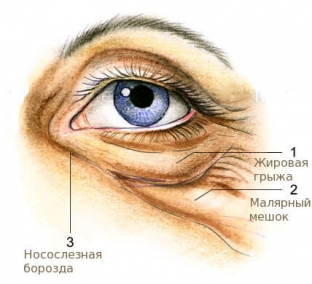The formation of the nasolacrimal sulcus is one of the most characteristic signs of aging, and at the same time one of the most complex cosmetic problems. Many other age-related facial defects can be corrected quite easily, however, work in the periorbital zone is a complex process that can lead to occurrence of serious complications. Today estet-portal.com brings to your attention the TOP 3 cosmetic techniques that most effectively cope with the task of filling the nasolacrimal trough and help restore the patient's face to a rested, healthy and young look.
Modern cosmetic methods for filling the nasolacrimal trough
The age-related formation of the nasolacrimal sulcus on the human face is primarily due to the anatomical features of the periorbital zone, namely the presence of a dense septum. With age, the ligaments that attach it to the bone and skin weaken and stretch, resulting in tissue retractions in areas with greater fixation and protrusions in areas with less.
The nasolacrimal sulcus is a fold under the orbital edge of the bone, approximately 1 cm long, which delimits the infraorbital region.
Currently, filling the nasolacrimal sulcus is possible through injection and hardware cosmetic techniques.
Lacrimal trough filling:
- hyaluronic acid to fill the nasolacrimal trough;
- filling of the nasolacrimal trough with lipofilling;
- hardware methods for filling the nasolacrimal trough.
Hyaluronic acid to fill the nasolacrimal trough
Today, injection techniques are one of the most effective methods for correcting the nasolacrimal sulcus. This correction is most often carried out by means of contour plastics using fillers based on hyaluronic acid, and mesotherapy is effective in order to prevent the formation of a furrow. Low-density fillers are suitable for filling the tear trough, as the skin in this area is very thin. It is recommended to work in the periorbital zone with a cannula, since the zone is quite dangerous and complex, so there is a high risk of complications. On average, the effect after filling the nasolacrimal trough with hyaluronic fillers lasts about 6-8 months.

Filling of the nasolacrimal trough with lipofilling
Lipofilling – this is another effective cosmetic method for filling the nasolacrimal trough. This procedure involves injecting into the region of the nasolacrimal sulcus the patient's own adipose tissue, which is removed from the abdomen, thigh or other parts of the body, centrifuged and washed, and then injected under the skin. The effect after such a procedure lasts longer than after introduction of fillers – about 3 years old. However, it has its drawbacks, for example, over time, the drug can be contoured on the surface of the skin, creating an uneven relief. An important role is also played by the fact that some of the fat cells do not take root after the procedure, due to which its effectiveness also decreases. The final decision on which injection technique to choose to fill the nasolacrimal trough,
Hardware methods for filling the nasolacrimal troughHardware techniques are much less effective in correcting the nasolacrimal sulcus, so they are used not as independent procedures, but as an addition to injection techniques. These include:
- RF-lifting and thermage - exposure to high-frequency electromagnetic pulses that stimulate the production of
- elastin and collagen fibers by fibroblasts, deep impact of ultrasonic waves on the muscular-aponeurotic system, which has a lifting effect.
Filling of the nasolacrimal trough – this is a procedure that can only be performed by a highly qualified specialist with sufficient experience in the periorbital area.Read more articles about the method of correcting age-related changes in the face on estet-portal.com in the "Cosmetology" section.







Add a comment